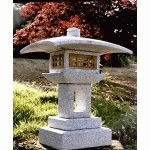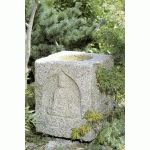Well, what is it you really want?
Is it a true to period Japanese structure, with Mount Fuji in the background, or an impression of style, elegance and basically easy maintenance?


We in the UK enjoy dabbling in cultures, Indian, French, Chinese, Japanese. Its nice to take a little of their style and apply it to our own existences.
You will no doubt be constrained by the type of area you have – you may be really lucky and have unlimited area in which to create your own serenity, but generally, most of us are not that lucky.


We like Japanese Gardens because they are easy maintenance, they have a style that immediately says something about their creators, and they are not overpowering.
We can look for unusual items to place into our Japanese area – we can introduce fish, be it humble goldfish or expensive Koi – but they have a presence and place because they are within a setting.
Setting is most important, many of us move houses, and your setting changes frequently. It is nice to easily recreate the form and sentiment of our previous existences and isn’t that what the Japanese garden is all about? – just letting time continue. So, you can pick up your statues, pick up your lanterns, and with a bit of thought – move them and reposition them as your would move your furniture.
Some of our pieces will be maturing nicely outside, the granite taking on a different hue, possibly growing lichen and moss – so why not? – they are as much a part of you as your pictures and paintings.
You have so many options to start making a space your own, from garden statues to water features. The noise and clean air around a little stream is beautiful, and it’s the little touches that turn a pebbled area into a Japanese island of retreat – the items which are perhaps difficult to pronounce but get easier after a glass of wine.
If these items are well made, and of tradition, they stand the test of time. Not many items can ascribe to such heights but we hope ours will.
The various styles of Japanese Gardens
In addition to trees and shrubs, the Japanese garden makes artistic use of rocks, sand, artificial hills, ponds, and flowing water.In contrast to the geometrically arranged trees and rocks of a Western-stvle garden, the Japanese garden traditionally creates a scenic composition that, as artlessly as possible, mimics nature.
Garden designers followed 3 basic principles when composing scenes. They are reduced scale, symbolisation, and "borrowed views". The first refers to the miniaturisation of natural views of mountains and rivers so as to reunite them in a confined area. This could mean the creation of idealised scenes of a mountain village, even within a city. Symbolisation involves abstraction, an example being the use of white sand to suggest the sea. Designers "borrowed views" when they used background views that were outside and beyond the garden, such as a mountain or the ocean, and had them become an integral part of the scenic composition.
The basic framework of the Japanese garden, according to one school of thought, is provided by rocks and the way they are grouped. Ancient Japanese, we know, believed that a place surrounded by rocks was inhabited by gods, thus naming it amatsu iwasaka (heavenly barrier) or amatsu iwakura (heavenly seat). Likewise, a dense cluster of trees was called himorogi (divine hedge); moats and streams, thought to enclose sacred ground, were referred to as mizugaki (water fences).
Japanese gardens can be classified into 2 general types: the tsukiyama (hill garden), which is composed of hills and ponds, and the hiraniwa l (flat garden), a flat area without hills and ponds. At first, it was common to employ the hill style for the main garden or a mansion and the flat style for limited spaces. The latter type, however, became more popular with the introduction of the tea ceremony and the chashitsu (tea-ceremony room).
Planting and Plants
Japanese gardens are very important to the Japanese.
All of the gardens are representations of nature. The purpose of these gardens in to capture nature is the utmost natural way, and do it with a touch of artistic feeling. Japanese gardens are built for endurance and to withstand and harmonise with the typically wet weather of Japan.
The essential elements to a Japanese garden–water, garden plants, stones, waterfalls, trees, and bridges–create this symbolism.
Trees and plants give the Japanese garden its unique character. The Japanese garden is predominately green with its almost exclusive use of evergreen trees. When flowering trees are found in the Japanese garden they are usually camelias. , For colour, (Japanese gardens are mainly stone, moss, bushes, trees and bamboo – limited colour) the Japanese use Azaleas for deep pinks and Cherry trees for pink blossom in Spring.
The pine tree stays green during the whole year and, therefore, symbolizes youth and longevity. Bamboo grows very fast and is also an evergreen, be careful the roots of bamboo are very strong. Never place bamboo to close to a pond. There are also many small kinds of bamboo. The plum tree carries beautiful blossoms in the spring. The Japanese garden makes artistic use of rocks, sand, artificial hills, ponds, and flowing water.
A Japanese garden is a quiet place, allowing people to look back and reflect or meditate. In a Japanese garden there is a respect for nature. The understatement and simplicity of design add dignity and grace to the japanese gardens, making a clean and unique statement. These gardens give many impressions to those who appreciate them and they move people in various ways.
Histrory of Shrine Lanterns
In Japan the native Shinto religion soon adopted the lanterns for ceremonies that were often held at night, the flicker of candlelight creating a beautiful effect, they were used until the 16th century, and later hanging lanterns were used in Japanese temples and shrines often for ornamental rather than functional purposes. They were hung outside usually at each of the four corners of the building or used to light doorways. Later with the refinement of the Japanese tea ceremony, hanging lanterns came into private use where they were hung under eaves of homes, in Japan many lanterns may be seen hanging in large numbers from the eaves of temples
Do’s and Don’ts of Japanese Gardening, by Allan Toombs
Too Much – Japanese planting is sparse. Being British we can’t help but pack plenty in, herbaceous borders are in our blood. Resist, resist, leave space.
Too Many – Britons are great collectors, we even refer to plantsman’s gardens meaning ‘they have one of every variety’. The japanese use a limited
plant palette, this immediately increases cohesion and tranquility whilst the repetition of form highlights the odd specimen plant.
Bamboo – Nothing signifies the East more to the Western mind, and we tend to overuse it. Bamboo does have a role in courtyard gardens, as either a sparse vertical or a low, grassy square, but not the overgrown clump.
Rock – We never seem to incorporate enough rock. I can see why though as selling a house with two ton boulders in challenges the buyer’s makeover skills. However cobble and gravel zones will give punctuation to the plants. Hard to overdo!
Handling Heavy Granite:
Most of our products, can be lifted by one or two people and placed on a low wheeled dolly or "sack truck" to be moved, lanterns generally come in sections such as the "Rokkaku -Yukimi" in five pieces, or the Kasuga / Sangatsu -do, in six pieces. Very heavy items in one piece granite may require specialist handling such as the impressive 6ft long Maruta bridge at 590kgs, or the fabulous life size 6ft Terracotta Warrior at 650kgs
LIFTING LOADS SAFELY
Last year, approximately one out of every 25 UCLA Medical Center employees reported a back injury. Most resulted from using poor technique or bad posture when lifting or moving heavy items.
Your body is not designed to lift heavy weights. The way you carry a heavy object can subject your back to pressures two to ten times the object’s actual weight. The pressure is increased more as you hold the load away from the body.
Safe lifting is a function of both the amount of weight being lifted and the lifting technique used. Always test the weight of unfamiliar loads before lifting. If a load is too heavy or awkward, have a co-worker help, or use equipment such as a cart or dolly. Here are some hints to help you lift safely:
Know where you are going before you lift a load. Pre-plan your lift.
Keep your legs shoulder width apart for good balance.
Take a deep breath and tighten your stomach muscles. Conditioned stomach muscles can serve the same purpose as back belts to protect your back when lifting.
Bend at your knees and hips, not your waist. Try to keep the natural curves in your back when bending and lifting.
Lift using your leg muscles to reduce the load on your back.
Lift smoothly; don’t jerk as you lift. Sudden movement and weight shifts can injure your back.
Keep your back in alignment, with your ears, shoulders and hips lined up. our nose and your toes should be facing the load when lifting.
Hold the load close to your body at waist height to reduce the force on your back.
Turn with your feet, not your back to avoid twisting when lifting.
